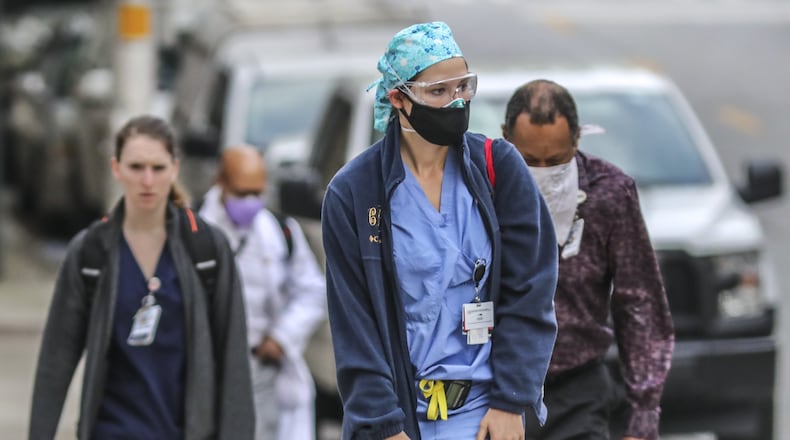I never imagined I would be a front-line physician in an infectious disease outbreak as an orthopaedic trauma surgeon.
Yet, every day this month, I fastened my worn N95 mask onto the painful, bruised bridge of my nose, and lined up to have my temperature taken at the hospital entrance. I marched into the operating room, put on my usual 15-pound lead suit, and covered my face with shields and extra masks.
In a recent week, I suited up under these suffocating conditions for 20 surgeries – twice as many as that week during last year. My patients included six gunshot victims. There were three people who fell from heights, two who stepped out in front of moving cars, and one person who raced his car directly into a tree. I still have no idea what they were doing – but they clearly were not sheltering in place.
Reports suggest that hospital volumes in the U.S. are down about 50% since COVID-19 started. Injuries have decreased overall, as many people are staying home, as outlets like CNBC and others have reported. These statistics are highly variable based on hospital setting and geography, with many medical centers – like mine – having to strike a balance between COVID-19 care and other steady urgent issues. Vanderbilt University Medical Center reports a 22% reduction in trauma-related admissions compared to last year. At Grady Memorial Hospital, our total orthopaedic trauma volume has dropped 30%. Worldwide, New Zealand's trauma-admission rates are down 43%, says the National Institutes of Health. In Italy, one of the hardest-hit COVID-19 regions, there has been a 50% reduction in trauma. "Our major traumas are typically caused by car crashes and work accidents. Now, people cannot move, they cannot go to work, they aren't playing sports – so we are seeing fewer injured patients in the hospital now," reports Trauma System News. These trauma statistics are likely closely linked to the number of people who are actually sheltering in place.
Over the last few weeks, streets have been quiet, and homes have been locked down – proving to be ill-predicted, opportunistic hosts for traumatic injury. Although many U.S. roads are relatively desolate, those who remain on the streets have been traveling at dangerously high speeds. The Governors Highway Safety Association noted a "severe spike in speeding." In cities like Chicago and Los Angeles, drivers are reaching speeds nearly 75% higher than a typical pre-pandemic day, CNN and other news outlets have reported. One police officer in Sandy Springs clocked a motorcyclist racing by at the unimaginable speed of 172 miles per hour.
Violence is also surging. Compared to the same month last year, firearm-related injuries are up from 11% to 19% in our department, similar to other reports. In Georgia, gun and ammunition sales are spiking, according to AJC reports. In Baltimore, the mayor begged its residents to stop shooting each other so that hospital beds could be conserved for coronavirus patients. Domestic violence and child abuse have also flourished in lockdown. Substance-use rates are climbing, likely compounding the domestic violence surge. Drug-overdose deaths have increased, as have suicide hotline calls. The effects of the pandemic on violence, substance use, and mental health are likely far greater than most realize.
Prior to the pandemic, trauma was the third-costliest medical condition in the U.S., according to Business Insider.com. Many of the expensive resources required to provide trauma care are the same as those that are now precious during the pandemic, including personal protective equipment (PPE), operating room time, ventilators, intensive care unit beds, and blood transfusions.
The American College of Surgeons recently revised its longstanding trauma protocol to help conserve resources. As part of this, the initial “trauma activation” – which is the first evaluation a patient receives when they arrive to the hospital – has been modified. This used to be a highly interactive orchestration between multiple specialists, and is now restricted to a core group. Many specialists (including orthopaedics) were previously considered “essential” to the process, but are now asked to refrain from participating, unless specifically called, to conserve PPE. Further, due to social distancing and the fear of donation and disease transmission, there has been a drop in the available blood supply across the country. Blood transfusion is a key component of trauma resuscitation, and unless donors increase or need drops, trauma care may soon be impacted.
As the spring weather arrives, and our states are starting to reopen, we as trauma care providers ask you all to be safe. Traumatic injury, including that from reckless driving and violence, is using many of the precious resources that we need to defeat this pandemic. Please slow down while driving, and by all means, we beg you, please stop shooting each other.
Dr. Mara L. Schenker practices at Grady Memorial Hospital and is affiliated with Emory University’s Orthopaedic Surgery Department, where she is director of orthopaedic trauma research and an assistant professor.
About the Author
Keep Reading
The Latest
Featured

